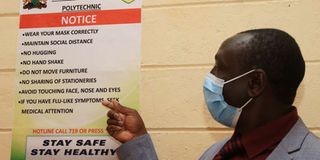Breaking News: At least 10 feared to have drowned in Makueni river
What the post-pandemic school is likely to look like

Emphasis should be on the precautions a school should take to prevent coronavirus from spreading.
What you need to know:
- Schools might reopen briefly and made to close again temporarily, depending on the local context.
- But with the evolving situation, authorities will need to be flexible to ensure students’ safety.
- The ministries of Health and Education and BoMs must improve hygiene measures.
- Learners, educators and support staff should be trained on containment measures upon reopening.
With the difficult life for adults and children during the Covid-19 pandemic, school reopening is an important and, hopefully, welcome step. But resumption of learning will not be easy.
We are seeing an increasing number of students the world over return to the classroom. But more than a billion others are still at home due to school closures, even as over 90 countries, including Kenya, announced plans to reopen schools.
But the governments will have to consider public health, the benefits and risks for education and other factors, such as adequate infrastructure and supply of fresh water, sanitisers, face masks, furniture, learning materials and teachers and support staff. The best interest of teacher and child should be at the centre of these decisions, though that will vary.
The World Health Organisation and Unicef insist that schools should only be reopened when it is safe for students; hence, going back to school will likely look a little different from what we were used to. Schools might reopen briefly and made to close again temporarily, depending on the local context. But with the evolving situation, authorities will need to be flexible to ensure students’ safety.
Health protocols
Emphasis should be on the precautions a school should take to prevent coronavirus from spreading. Reopening should be consistent with Covid-19 health protocols. The practical measures that boards of management can take include staggering the start and close of the school day and also meal times, creating temporary classrooms outdoors, holding lessons in shifts to reduce class sizes and creating extra hours to recoup the lost time.
The ministries of Health and Education and BoMs must improve hygiene measures — including handwashing, respiratory etiquette, physical distancing, cleaning procedures and safe food preparation. To reduce contact between learners, steady supply of learning materials in schools and suspension of sports and games could be necessary. Staff should be trained on physical distancing and hygiene.
It should also be noted that, during such a worrying and disruptive time, it is natural to have many questions. For instance, what steps will schools take to ensure the safety of learners? How will they support their mental health and combat stigma against people who were infected with the virus? How will they refer children for specialised support?
Schools should plan for catch-up lessons for learners — including introducing after-school pre-fresher or remedial courses or supplemental assignments to be done at home or during prep time. Parents will have to network with teachers and school management to stay informed of the students’ performance.
Learners, educators and support staff should be trained on containment measures upon reopening.
Mr Sossion, a nominated MP, is the secretary-general of Knut. [email protected].





